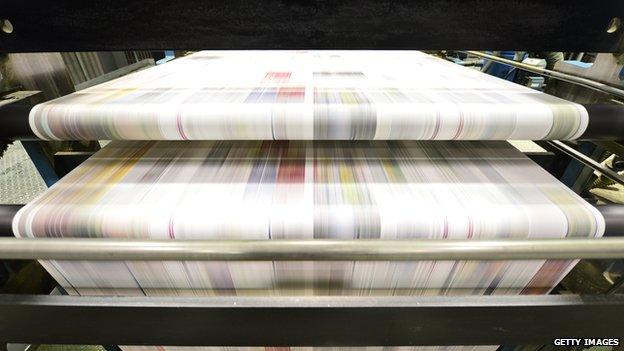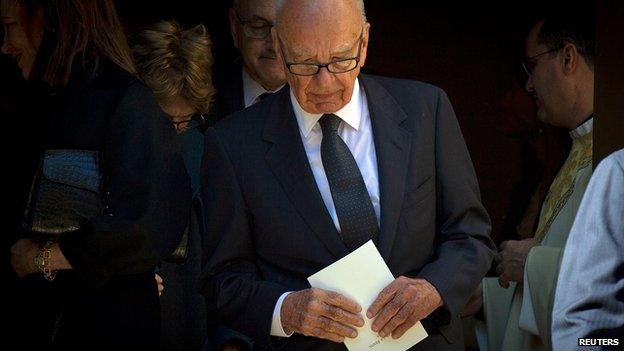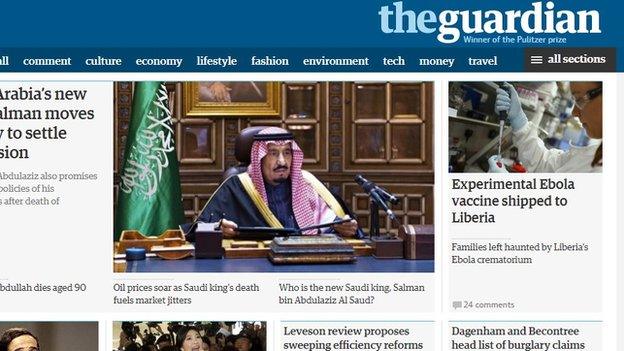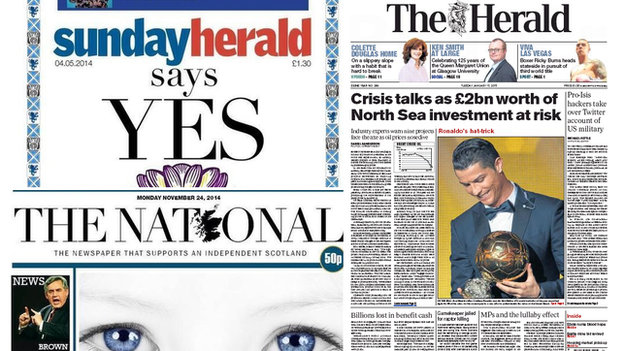Future of news: Is it possible to make news pay?
- Published

Sales of many newspapers are in decline and the loss of cover price revenue isn't the only problem that creates
If you follow the news - this is a golden era. Never before has so much been available for so little.
If you write the news - oh dear.
Sales of UK national newspapers have dropped by around 40% over the last 10 years and it's even worse for some local and regional titles.
They have lost not just the cover price but also swathes of advertising revenue, which has made a dash for new digital outlets (Google, Facebook and the rest).
This is not just a loss of money but vital content. We may worry about news stories but readers buy papers for a bundle of attractions and this includes property ads, car ads, situations vacant, lonely hearts. All have to one degree or another been turned into separate digital businesses that have gutted many newspapers. And who's been doing it? The media companies behind the newspapers. The Daily Mail is behind Zoopla, the Guardian has just sold off Autotrader.com.
After years of being the highly paid, high esteemed peacocks of media - journalism has become a millstone and a legacy business of costs and habits.
No definitive answer
Indeed, the great trend of the last 12 months has been spinning off news from all the other profitable businesses and trying to make it pay its way. Time-Warner owns many media businesses, HBO, Boomerang, DC Comics, Hanna Barbera cartoons but not Time. It used to be the Cadillac of news magazines. Now it and a whole stable of magazine brands are on their own.
And this is not just about 'digital'. Sales of Sunday papers have been declining for 60 years. The average household bought 2 papers in 1950, now less than half buy one.

Rupert Murdoch's newspapers are leading the way with online 'paywalls'
That's a drop from 30 million to 7 million.
So how do you make news pay? It's tough and no one's really got the answer - but ideas are flowing (but not as fast as journalist jobs are going).
Make 'em pay!
Leading the way on charging for news in the UK is Rupert Murdoch and the Times and Sun 'paywall'. The Times has even claimed that it is now making a small profit after years of losses.
There are doubts about some of the sums and how the costs are being divided up that led to that profit but one thing has definitely happened - The Times is the only national newspaper that has over the last 12 months stopped the decline in print sales. It seems that if you can't get it for free, your loyal readers may stick with paper - for the time being.
The same has not happened for the Sun. Sales are still dropping. And with a 'paywall' there is no chance of getting the millions of hits that bring the advertisers. The other problem is picking up new customers - where will tomorrow's subscribers come from if no one can click on your stories to see what you are up to?
Make 'em click!

The Guardian's digital income is £69m
This is the Daily Mail and Guardian approach; 'Go digital' and switch to an advertising led model.
It changes the journalism (just compare the print Daily Mail with the online version), but there is instant feedback on a story. If the people click then give them more. It's propelled the Mail and the Guardian in to the global league of newsbrands. Some 80% of the Mail's traffic comes from outside the UK. But riches? The Guardian's annual digital income is £69m. The Mail's is £62m.
Digital First
Nestled just behind the New York Times as one of the world's biggest generators of revenue is a Norwegian firm Schibsted. How? It was one of the first to realise that the future was not trying to take your existing print product and selling it on the internet (which is what the other 2 models are essentially).
They moved into online advertising in a big way and did everything to ensure that people would go to them for reasons beyond news (the Zoopla and Autotrader strategy but integrated with an online news product). This coupled with a reputation for being first with the news (remember some rival newspapers are still holding stories back for tomorrow's print edition) has made it one of the most talked about digital transformations. It separated its digital business from its print operation back in the late 1990s.
One of the consequences is that more people visit their sites rather than click through from Google or Facebook. This is perhaps closer to the real newspaper model which is essentially a forum for selling things which is made more enticing with some exciting stories. Essentially, they grasped that a newspaper was a space in which you captured people's attention and sold them things.
They tried to create an environment online in which to dwell rather than to absent-mindedly click through. But if you want to understand 'digital first' then I would suggest reading this leaked report from the 'The New York Times', external. It has a clarity and punchiness that makes it a 'must read' for anyone interested in the news business.
The rest
There are other suggested options, including;
Micropayments. It may come but the system of making easy one click payments that are widely adapted is not yet with us. If a headline looks too juicy to miss it might work, but would probably take seconds to bounce round the web in a 'free' version
Big subscriptions. For content that is vital then people will pay. The company behind the Daily Mail now makes around a 3rd of its revenue from subscriptions. It's news and analysis but for a specialist audience
Voluntary contributions. The Kickstarter, Wikipedia route. For one-off projects it has worked. None of the big newspapers have gone down the charity route just yet
Sponsored news. Plenty of stories are washing around the web which are barely concealed adverts. Even some 'real' stories increasingly offer you a chance to buy the outfit in the photo.
This is just a fraction of the ideas being tried out but it is worth realising that whatever works will affect the nature of the news we receive. Already newsrooms are grasping that instantaneous reaction is changing news values. Who will pay for news that we ought to know but not many people click on? Like it or not we are moving in to an ever more demand driven news agenda. Have a look at this fascinating website, external on what the editors think we should read and what demand driven front pages would look like.
Some 95% of people say they follow the news. But what does that actually mean? Perhaps one of the most sobering pieces of research on news was this recent study, external. It followed 1.2 million web users for 3 months - they clicked on 2.3 billion pages. The number who read at least 10 traditional news stories (no sport, no celebrity, no lifestyle) and 2 comment pieces over those 3 months? Just 4%.
Hard news, political news, investigative news has in many ways been subsidised. There may be lots of fun information out there but news is expensive.
- Published30 January 2014

- Published13 January 2015
